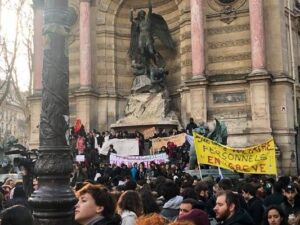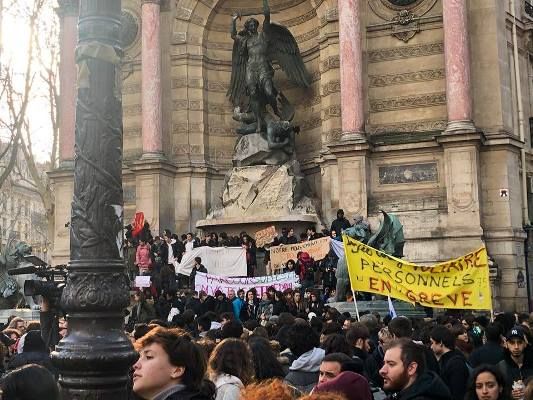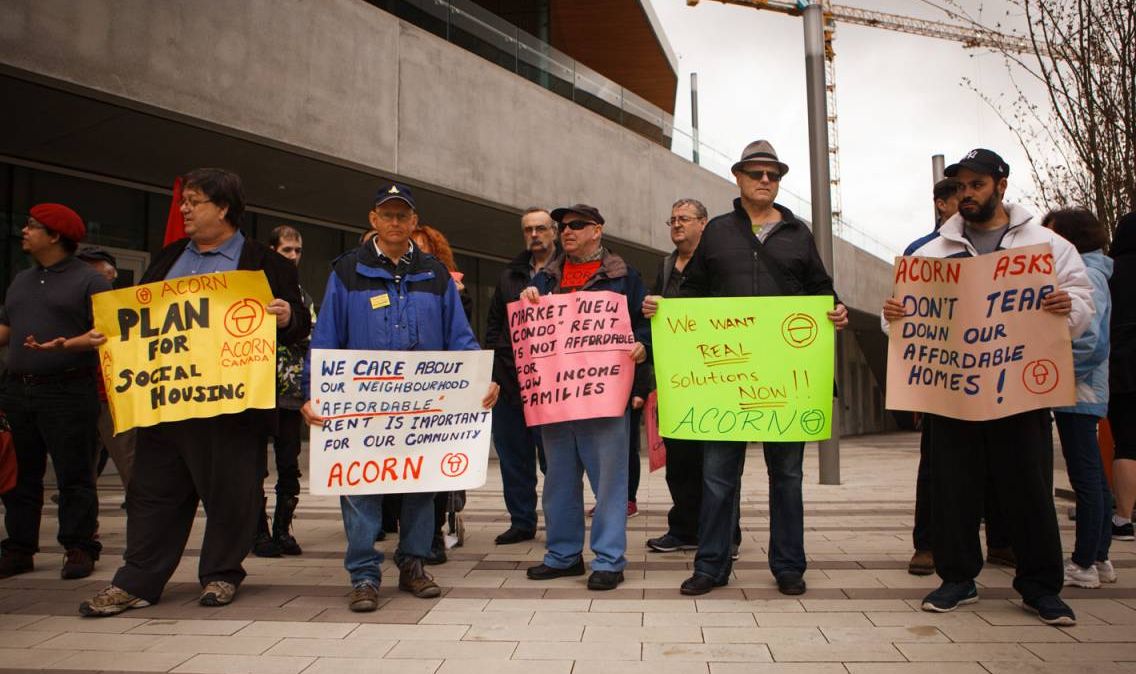Leïla Messaoudi is a member of Gauche Révolutionnaire (CWI in France).
 The “yellow vest” movement in France has involved hundreds of thousands of people in demonstrations, blockades of roundabouts, main roads and toll booths all around the country, in big cities and in the countryside. Begun in mid-November, it has not even stopped during the festive season, and it’s not finished yet
Officially, according to the government, 85,000 people were on the streets on the 12th of January, 2019 – double the numbers for the previous Saturday.
Plans were drawn up for the following Saturdays to have mobilisations, demos or actions locally by yellow vest groups all around the country and on Sundays specific yellow vest women’s demonstrations! A social and political crisis has opened up. The original reasons why people went on the first actions are not solved at all. And Macron is under very severe pressure from below.
The yellow vests movement is a social revolt against Macron and what he represents. At the heart of it are insecure/casual workers, part-time women workers, small farmers, unemployed people. Fed up with price increases on oil, energy, food etc., revolted by presents for the richer in society and nothing for the rest of the population, disgusted by the corruption of the government and the lack of democracy, they are not ready to give up the fight.
This is especially because, day by day, Macron and his government are showing their incredible arrogance towards “those from below”. Just before the Saturday demonstration on the 12th of January, Macron complained against “those French people who don’t have the taste for making an effort”. In spite of whatever the main media do to present the yellow vest movement as a violent, uneducated, wild people’s movement, every week surveys show a large level of support (55%) amongst the population for the “yellow” wave.
The nature of the movement
The layers of people involved in the yellow vest movement have come into a sort of uprising against Macron and society. On the roundabouts, in the demos and actions, they are giving all their personal resources. Some have resigned from their jobs, some are demonstrating on Saturdays, Sundays and doing all the activities and protests… Their energy has been the fuel of the movement. But after two months, all this is not sufficient and the movement is not growing any more.
The difficulties of coordinating and deciding collectively haven’t allowed political clarification inside the movement about its programme, except in some regions where general assemblies have been created during the first month. In some areas, joint action has been held with unions or workers in front of their workplaces. But nationally, the absence of the organised workers’ movement in the form of trade unions is a key failure in the movement’s capacity to extend and develop clear working class aims and program.
The yellow vests have a clear consciousness of being against Macron and the rich, but they are not clearly conscious that they are part of a class – the working class – which is the only one capable of overthrowing Macron and his policies.
Strikes and mass movements have not yet been put on the agenda in the struggle against Macron. The fact there are now no real new layers and trade unions clearly joining on a national scale is limiting the movement itself. The big repression and violent clashes during demonstrations is also discouraging a lot of people from joining in to make a big movement against Macron.
The yellow vests are facing ferocious repression. Thousands have been injured, some of them losing an eye or a hand after the special police fire ‘flashballs’ (rubber bullets) or ‘defensive’ grenades. So-called “preventive arrests” are taking place before demonstrations to avoid some of the yellow vest protesters going to the events. Official figures show that since the 17th of November last year, 6,475 people have been arrested and 5,339 taken into police custody. No less than ten people have died on the blockades because of car accidents or as a consequence of police action – a sad record, which underlines the fear amongst the ruling class and in the government. Many activists – more than 150 by the middle of February – have been condemned to jail for several months or even a year for their actions to defend themselves against the police.
Macron attempts to take back control
Macron has tried to use the political confusion that exists. He was obliged, in the early stages to step back for a while on some very unpopular measures – on fuel prices and pensions. But, now, he is trying to recover. He has launched “the big national debate” which is supposed to be organised locally by mayors. On Monday the 14th of January, each French citizen received a letter from Macron to explain what he wants to discuss. Certainly, the vast majority of the yellow vests don’t trust one word of Macron’s. But he hopes he can win his electorate back, or at least address a larger layer who are not involved in the movement, who might want a more peaceful situation and can be influenced. It is not at all certain that he will succeed.
At the moment, Macron wants to avoid any electoral damage especially four months before the European elections which can become a sort of referendum against him. The political situation is particularly unstable because Macron has a capitalist agenda to follow on the “reform”, of pensions and of social care over the coming months. The struggle has opened, and it’s only the beginning!
There will be a “before” and an “after” the yellow vest movement, because, on a broader scale, everything has been shaken for two months by the movement without any possibility for the government or any party to end it. The level of hate against Macron is very high amongst large layers in society. He has to hide in the Elysée Palace in Paris and cancel his travel plans because it seems too risky for him to have a public appearance.
It makes other layers in the country want to take action to change their own lives too. At the beginning of this new year, some movements have been launched on the same model as the “yellow vests” on the internet or on the streets – discontented lawyers, the “red pens” movement in education and the “pink vest” childminders… A big part of the population is looking at the situation very seriously. The second round in 2019 is possible!
Amongst the youth, especially school students, the sympathy for the yellow vests is real and the willingness to revolt is potentially high. The yellow vests movement will probably not develop as a unified movement of strikes and protests, but it is clearly a breach that has been opened for much larger involvement of the working class and the youth in the struggle against Macron. For the moment, the industrial working class isn’t in the struggle with the yellow vests, particularly because trade union leaderships have not been open towards the movement. Macron and the bosses’ agenda is a wake-up call to organise urgently together with youth and pensioners and to address the wider population.
A breach is open!
It is clear that the trade union leaderships have not done anything to really link up with the yellow vests. But a big part of the trade union fighters and left activists don’t know what to do in the situation and are also dismayed. They didn’t even know if they should intervene in this kind of movement in which, they are afraid, there are political confusion and some reactionary ideas. In reality, a lot of the very good activists are also confused and have no idea how to address the broader layers.
There is a need to propose a program which links concrete demands, which can give confidence to workers and youth broadly, and give a political perspective to overthrow Macron and the capitalists with him. This vacuum is an expression of the absence of a new workers’ party for socialism. Melenchon and the ‘France Insoumise’ (FI) are in the middle of the road. A lot of FI activists are involved in the movement, much more than other left organisations. But being a member of the FI is not enough; the organisation doesn’t help its members to intervene and build the movement. It’s a historic responsibility for the Left.
In the present situation, Gauche Révolutionnaire argues that it is particularly important to discuss widely – in the unions, in our social and political organisations and in the Left – our transitional demands. This means arguing the case for the struggle for wage increases, indexation of prices and also about public services and the need to struggle for re-nationalisation under the control and management of the workers and the population. The political crisis will continue to develop. It is time to seize the opportunity and build the forces for revolutionary socialist change.
The “yellow vest” movement in France has involved hundreds of thousands of people in demonstrations, blockades of roundabouts, main roads and toll booths all around the country, in big cities and in the countryside. Begun in mid-November, it has not even stopped during the festive season, and it’s not finished yet
Officially, according to the government, 85,000 people were on the streets on the 12th of January, 2019 – double the numbers for the previous Saturday.
Plans were drawn up for the following Saturdays to have mobilisations, demos or actions locally by yellow vest groups all around the country and on Sundays specific yellow vest women’s demonstrations! A social and political crisis has opened up. The original reasons why people went on the first actions are not solved at all. And Macron is under very severe pressure from below.
The yellow vests movement is a social revolt against Macron and what he represents. At the heart of it are insecure/casual workers, part-time women workers, small farmers, unemployed people. Fed up with price increases on oil, energy, food etc., revolted by presents for the richer in society and nothing for the rest of the population, disgusted by the corruption of the government and the lack of democracy, they are not ready to give up the fight.
This is especially because, day by day, Macron and his government are showing their incredible arrogance towards “those from below”. Just before the Saturday demonstration on the 12th of January, Macron complained against “those French people who don’t have the taste for making an effort”. In spite of whatever the main media do to present the yellow vest movement as a violent, uneducated, wild people’s movement, every week surveys show a large level of support (55%) amongst the population for the “yellow” wave.
The nature of the movement
The layers of people involved in the yellow vest movement have come into a sort of uprising against Macron and society. On the roundabouts, in the demos and actions, they are giving all their personal resources. Some have resigned from their jobs, some are demonstrating on Saturdays, Sundays and doing all the activities and protests… Their energy has been the fuel of the movement. But after two months, all this is not sufficient and the movement is not growing any more.
The difficulties of coordinating and deciding collectively haven’t allowed political clarification inside the movement about its programme, except in some regions where general assemblies have been created during the first month. In some areas, joint action has been held with unions or workers in front of their workplaces. But nationally, the absence of the organised workers’ movement in the form of trade unions is a key failure in the movement’s capacity to extend and develop clear working class aims and program.
The yellow vests have a clear consciousness of being against Macron and the rich, but they are not clearly conscious that they are part of a class – the working class – which is the only one capable of overthrowing Macron and his policies.
Strikes and mass movements have not yet been put on the agenda in the struggle against Macron. The fact there are now no real new layers and trade unions clearly joining on a national scale is limiting the movement itself. The big repression and violent clashes during demonstrations is also discouraging a lot of people from joining in to make a big movement against Macron.
The yellow vests are facing ferocious repression. Thousands have been injured, some of them losing an eye or a hand after the special police fire ‘flashballs’ (rubber bullets) or ‘defensive’ grenades. So-called “preventive arrests” are taking place before demonstrations to avoid some of the yellow vest protesters going to the events. Official figures show that since the 17th of November last year, 6,475 people have been arrested and 5,339 taken into police custody. No less than ten people have died on the blockades because of car accidents or as a consequence of police action – a sad record, which underlines the fear amongst the ruling class and in the government. Many activists – more than 150 by the middle of February – have been condemned to jail for several months or even a year for their actions to defend themselves against the police.
Macron attempts to take back control
Macron has tried to use the political confusion that exists. He was obliged, in the early stages to step back for a while on some very unpopular measures – on fuel prices and pensions. But, now, he is trying to recover. He has launched “the big national debate” which is supposed to be organised locally by mayors. On Monday the 14th of January, each French citizen received a letter from Macron to explain what he wants to discuss. Certainly, the vast majority of the yellow vests don’t trust one word of Macron’s. But he hopes he can win his electorate back, or at least address a larger layer who are not involved in the movement, who might want a more peaceful situation and can be influenced. It is not at all certain that he will succeed.
At the moment, Macron wants to avoid any electoral damage especially four months before the European elections which can become a sort of referendum against him. The political situation is particularly unstable because Macron has a capitalist agenda to follow on the “reform”, of pensions and of social care over the coming months. The struggle has opened, and it’s only the beginning!
There will be a “before” and an “after” the yellow vest movement, because, on a broader scale, everything has been shaken for two months by the movement without any possibility for the government or any party to end it. The level of hate against Macron is very high amongst large layers in society. He has to hide in the Elysée Palace in Paris and cancel his travel plans because it seems too risky for him to have a public appearance.
It makes other layers in the country want to take action to change their own lives too. At the beginning of this new year, some movements have been launched on the same model as the “yellow vests” on the internet or on the streets – discontented lawyers, the “red pens” movement in education and the “pink vest” childminders… A big part of the population is looking at the situation very seriously. The second round in 2019 is possible!
Amongst the youth, especially school students, the sympathy for the yellow vests is real and the willingness to revolt is potentially high. The yellow vests movement will probably not develop as a unified movement of strikes and protests, but it is clearly a breach that has been opened for much larger involvement of the working class and the youth in the struggle against Macron. For the moment, the industrial working class isn’t in the struggle with the yellow vests, particularly because trade union leaderships have not been open towards the movement. Macron and the bosses’ agenda is a wake-up call to organise urgently together with youth and pensioners and to address the wider population.
A breach is open!
It is clear that the trade union leaderships have not done anything to really link up with the yellow vests. But a big part of the trade union fighters and left activists don’t know what to do in the situation and are also dismayed. They didn’t even know if they should intervene in this kind of movement in which, they are afraid, there are political confusion and some reactionary ideas. In reality, a lot of the very good activists are also confused and have no idea how to address the broader layers.
There is a need to propose a program which links concrete demands, which can give confidence to workers and youth broadly, and give a political perspective to overthrow Macron and the capitalists with him. This vacuum is an expression of the absence of a new workers’ party for socialism. Melenchon and the ‘France Insoumise’ (FI) are in the middle of the road. A lot of FI activists are involved in the movement, much more than other left organisations. But being a member of the FI is not enough; the organisation doesn’t help its members to intervene and build the movement. It’s a historic responsibility for the Left.
In the present situation, Gauche Révolutionnaire argues that it is particularly important to discuss widely – in the unions, in our social and political organisations and in the Left – our transitional demands. This means arguing the case for the struggle for wage increases, indexation of prices and also about public services and the need to struggle for re-nationalisation under the control and management of the workers and the population. The political crisis will continue to develop. It is time to seize the opportunity and build the forces for revolutionary socialist change. 



